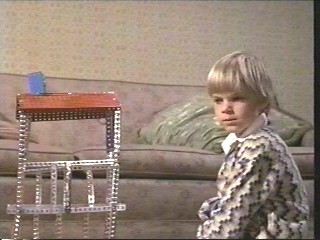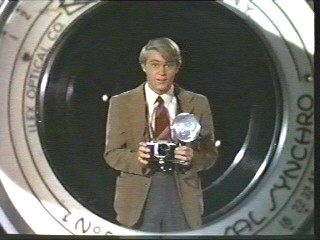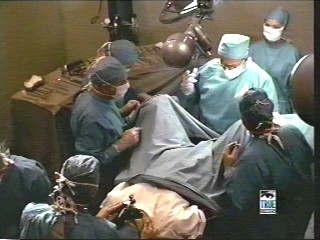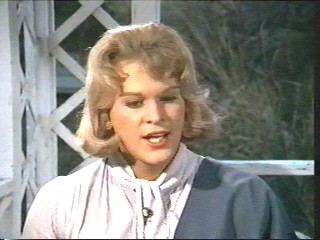
|
|
|
|
|
|
|
|
|
|
|
|
|
(1970) Director: Irving Rapper
If you've been fortunate enough to see movies covering a wide range of topics over a wide period of time, you will have seen a reoccurring phenomenon. That is, the perspective of the subject changes with the time. Take World War II films, for example. When the war was actually taking place, audiences were seeing war films that were almost entirely flag-wavers. They would show their strong-minded boys doing extremely well against fantastic odds against an enemy that often confirmed a stereotype going around at the time, and killing hundreds of them for every one of their own they happened to lose. After the war was over, the tone of the World War II films made during the next few decades changed. Gone was a lot of the flag-waving, in came more mud, casualties, and a sense of chaos and self-doubt, as well as an enemy that seemed closer to us in many ways than we had previously been made to think. A revision of this point of time slowly but gradually morphed so that today, recent movies like Saving Private Ryan can now show us the full horror that conflict was filled of. Sometimes revision has been good for a genre... but there are other times it hasn't been. Take the western genre. In the last few years we've had a number of westerns that take out the grit in order to place politically-correct pretty-boys instead, and with MTV-inspired directing and editing added to the mix to make dire results. (Examples: American Outlaws and Texas Rangers.) Which brings us to The Christine Jorgensen Story.
If there was at least one thing done right about its creation, it was
the decision to make it in the year it ended up being made in.
Previously, it probably couldn't never As it turned out, that's not what happened. Instead, the movie ended up being made in a way that could be considered even more bizarre. Except for some naughty stuff like nudity, The Christine Jorgensen Story could easily be mistaken for a Hollywood production that was made two decades earlier! I mean, the movie feels like it was made in the '50s right down to the opening credits! As the opening theme (strings with piano playing a la Liberace) starts to play, the credits are displayed - scrolling from the bottom to the top of the screen, just like many movies from that era opened. And just about everything else that follows - the sets, the camera angles, even the film stock - has that same old-fashioned feel. You have to wonder just how on earth the movie got made this way. One possible explanation may be because of director Irving Rapper being chosen to direct. Checking his credits, I discovered that almost all his serious work on films previously was in the 1940s and 1950s; it seems plausible to conclude that he was long out of practice. This may also explain why despite what seems to have been serious intentions, the movie turns out to be hilariously bad. Even though Jorgensen herself is listed as an advisor to the movie, it's laughingly obvious she had as much impact as Buster Keaton had on The Buster Keaton Story. After the opening credits unfold, we then are shown the
young George Jorgensen Jr., standing in an obviously phony city set on
some studio back lot as "My father was wrong," George tells us in his narration, adding, "For me, there were no tomorrows that weren't filled with loneliness." George grows into a man, shown to us by slowly increasing the size of an image of boy George (ha!) and subsequently quickly dissolving to the adult George (played by Hansen.) George has become a professional photographer at an ad agency, and we see that his knowing of how a queen should sit or a woman in a bathing suit should twirl around has become a great asset in his job. (When director Rapper isn't interesting in focusing the camera on pigeons or seagulls, that is.) But George is still fighting his personal hell. After his sister Dolly gets married, we see him lying in his bed, "Jealous I couldn't be a woman as she was," while a thunderstorm crashes and flashes from a nearby window. It doesn't help when a secretly gay male co-worker figures George is gay, and literally tries to rip off his pants one night during an out-of-town photo shoot. George manages to escape, and runs down to the docks to throw up. One of the swimsuit models sees the heaving George on the dock; she comes down from her hotel room, walks over to George just as he finished barfing, and says, "George... if you're going fishing, I can cut bait." Still, she manages to subsequently provide enough
comfort for George to realize he has to do something. As the fog on the
dock suddenly becomes thick enough to obscure everything, we cut to
George back in New York, doing research in a library. He finds his
salvation in a book titled Sex I will also spare you over George's subsequent post-operative treatment, except to warn any potential viewers that we get to see one shot of George's hormone-enhanced breasts. Actually, make that "Christine's", which is the name George rechristens himself. Not long afterwards, word leaks out about the secret operation, and it becomes a media sensation. Reporters camp outside the home Christine is staying at, yelling "Hey, Yorgensen! Ve vant a story!" Christine finally submits to being interviewed by American reporter Tom Crawford (Redeker, who later helped to script The Deer Hunter). They escape to the semi-desert countryside of Denmark so the story can be written in peace. During this time, Christine finds herself having feelings to Tom. And Tom seems to be developing feelings to Christine. But Christine is reluctant, and she not only resists her feelings, she wants Tom to return to America without her. Tom feels differently; he visits her one night, and they have one of those heart-to-heart talks where the woman cries at one point, but it all ends happily with a deep kiss in front of a roaring fire in the living room. Christine returns to America, and is met by the airport by a press that is still finding it hard to take this whole thing differently. What will Christine do? It's only 1953, after all, and we still have to see what she will do back in America in these circumstances. But the movie thinks otherwise, skipping immediately to the late '60s when America started to do its own sex change operations. To make sure we know this is a happy ending, we are treated to a shot of a sunset just before the end credits start to roll. I will admit that while watching The Christine
Jorgensen Story, a question kept going through my mind,
probably the same question a lot of you are thinking
Check for availability on Amazon (DVD) See also: Barefoot Gen, Men Cry Bullets, Sonny Boy |
 have been made due to the major
studios following the censorship code. Plus, people back then were for
the most part still pretty squeamish about the idea of someone having a
sex-change operation, let alone related topics like transvestitism and
homosexuality. (So you have to give Ed Wood some credit for having the
guts to make Glen & Glenda in the early '50, even
though it is a laughable film and extremely tame by today's standards.)
I can also doubt it being made later, with the then
blockbuster-mentality of the major studios; the closest it ever got was
when Vanessa Redgrave played Renee Richards in 1986's Second
Serve - which was made-for-TV, and significantly sanitized as a
result. But it was a different situation in 1970. The studios were more
willing to experiment with previously-taboo subject matter. Plus, the
censorship laws had been loosened - you could be adult enough to be an
"R" or even (gasp!) an "X". No doubt, legendary producer Edward Small (It!
The Terror From Beyond Space) had the opportunity to tell the
story without worrying about any details being censored. On the other
hand, there was still the risk that the movie might be made with too
much of a 1970s sensibility, becoming anachronistic for what took place
in the 1950s and earlier.
have been made due to the major
studios following the censorship code. Plus, people back then were for
the most part still pretty squeamish about the idea of someone having a
sex-change operation, let alone related topics like transvestitism and
homosexuality. (So you have to give Ed Wood some credit for having the
guts to make Glen & Glenda in the early '50, even
though it is a laughable film and extremely tame by today's standards.)
I can also doubt it being made later, with the then
blockbuster-mentality of the major studios; the closest it ever got was
when Vanessa Redgrave played Renee Richards in 1986's Second
Serve - which was made-for-TV, and significantly sanitized as a
result. But it was a different situation in 1970. The studios were more
willing to experiment with previously-taboo subject matter. Plus, the
censorship laws had been loosened - you could be adult enough to be an
"R" or even (gasp!) an "X". No doubt, legendary producer Edward Small (It!
The Terror From Beyond Space) had the opportunity to tell the
story without worrying about any details being censored. On the other
hand, there was still the risk that the movie might be made with too
much of a 1970s sensibility, becoming anachronistic for what took place
in the 1950s and earlier.  potato flake snow falls all around him. With an
unbelievably wicked grin on his face, he is seen looking in the window
of a toy store at a doll whose eyes are repeatedly go side to side -
just like his eyes are moving at that moment. We soon see that George
is not your average boy - he smashes his erector set in frustration
when he sees his sister Dolly across the room enjoying her doll. George
later states, "I don't like football - it's too rough!" and prefers to
play with Dolly and her friends in the schoolyard. "George plays real
good hopscotch, Dolly!" comforts one of her friends after George gets a
black eye from the boys who keep calling him a sissy. George's parents
seem pretty clueless as to what's going on with their son. All George's
mother can do is try to keep telling George that his sister "...has her
toys, and you have yours," whenever she finds George cuddling his
sister's dolls. George's father reacts to his unmasculine son by
enthusiastically photographing George with his first black eye, and
when his wife subsequently tells him that George's teacher discovered
George was smuggling a doll to and from school in his lunch box, he
dismisses it all by saying, "The boy will outgrow it!...Yep, everything
changes except photographs and things you remember!"
potato flake snow falls all around him. With an
unbelievably wicked grin on his face, he is seen looking in the window
of a toy store at a doll whose eyes are repeatedly go side to side -
just like his eyes are moving at that moment. We soon see that George
is not your average boy - he smashes his erector set in frustration
when he sees his sister Dolly across the room enjoying her doll. George
later states, "I don't like football - it's too rough!" and prefers to
play with Dolly and her friends in the schoolyard. "George plays real
good hopscotch, Dolly!" comforts one of her friends after George gets a
black eye from the boys who keep calling him a sissy. George's parents
seem pretty clueless as to what's going on with their son. All George's
mother can do is try to keep telling George that his sister "...has her
toys, and you have yours," whenever she finds George cuddling his
sister's dolls. George's father reacts to his unmasculine son by
enthusiastically photographing George with his first black eye, and
when his wife subsequently tells him that George's teacher discovered
George was smuggling a doll to and from school in his lunch box, he
dismisses it all by saying, "The boy will outgrow it!...Yep, everything
changes except photographs and things you remember!" & The Glands,
and goes to the trouble of studying as a medical assistant so he can
talk to its physician author about his problem. After some tests, the
physician tells him it's his glands alright, and tells him of a doctor
named Dahlman in George's ancestral land of Denmark. George immediately
takes the next boat to Denmark; Denmark, incidentally, turns out to be
a land of stock footage, rear projection, and phony city sets similar
to those found in New York. Dr. Dahlman is pleased to help George,
understanding George's frustrations in America. "Ah, you Americans,
you're advanced in so many ways! But when it comes to sex, childish!
Operate on the brain, perform a lobotomy, fine! But take a pair of
testicles, and everybody explodes!" Dahlman explains the details of the
never-tried-before sex change operation (which I will mercifully spare
you), and George without hesitation agrees to go through the long
process described. The day of the operation arrives, the details of
which I will also spare you, except that "Knife!" is yelled out loud at
one point. Oh, and George having vivid and symbolic dreams while being
operated on, consisting of things like him running in slow motion, and
footballs twirling through the air in slow motion as well.
& The Glands,
and goes to the trouble of studying as a medical assistant so he can
talk to its physician author about his problem. After some tests, the
physician tells him it's his glands alright, and tells him of a doctor
named Dahlman in George's ancestral land of Denmark. George immediately
takes the next boat to Denmark; Denmark, incidentally, turns out to be
a land of stock footage, rear projection, and phony city sets similar
to those found in New York. Dr. Dahlman is pleased to help George,
understanding George's frustrations in America. "Ah, you Americans,
you're advanced in so many ways! But when it comes to sex, childish!
Operate on the brain, perform a lobotomy, fine! But take a pair of
testicles, and everybody explodes!" Dahlman explains the details of the
never-tried-before sex change operation (which I will mercifully spare
you), and George without hesitation agrees to go through the long
process described. The day of the operation arrives, the details of
which I will also spare you, except that "Knife!" is yelled out loud at
one point. Oh, and George having vivid and symbolic dreams while being
operated on, consisting of things like him running in slow motion, and
footballs twirling through the air in slow motion as well. now: Were they serious? I
mean, a movie with such a dopey attitude towards its subject material
even in that day and age makes it hard to believe it was formed from
serious but misguided intentions. On the other hand, there are movies
like
now: Were they serious? I
mean, a movie with such a dopey attitude towards its subject material
even in that day and age makes it hard to believe it was formed from
serious but misguided intentions. On the other hand, there are movies
like